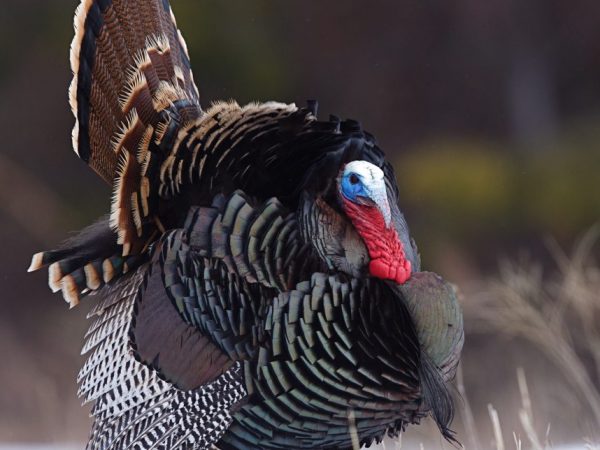Rules for keeping turkeys in winter
In many private farms today it is not uncommon to see turkeys that do not cause difficulties in keeping. Caring for them resembles what is suitable for other poultry such as chickens. However, if in the summer the birds are content with walking in the open air, the keeping of turkeys in the winter has some distinctive features.

Rules for keeping turkeys in winter
Premises preparation
Keeping turkeys at home in winter requires a spacious room. Given the size of these birds, no more than two birds should be placed per square meter.
To accommodate turkey livestock, poultry housesused for chickens that have enough room and an attached poultry area.
Moreover, the room, which will be intended for the winter keeping of turkeys, will have to be heated. This can be done in several ways:
- through natural heating, in which the required temperature regime is maintained due to natural preservation of heat,
- through the use of artificial heating systems.
With natural heating in the turkey growing room during the winter season, it is checked for existing cracks and holes that are caulked. The walls of the building must be insulated. At the same time, one should not forget that sometimes natural heating becomes insufficient to ensure a proper thermal regime. In such cases, an electrical appliance and gas boilers, infrared equipment are additionally installed in the premises where the bird is kept.
Creating a comfortable stay
Regardless of the fact that some birds (for example, Indo-Siberian birds) are able to survive even severe winter frosts, withstanding temperatures down to -15, when caring for turkeys in winter, they should create comfortable conditions that will not prevent them from developing correctly and will not affect turkey productivitywho lay the egg.

Create a comfortable environment for the bird
Litter
The litter on which they spend most of their time is of no small importance in the winter keeping of birds. Warm litter is a thick straw, peat or sawdust layer. To ensure the dryness of the bedding layer, it is changed:
- with an interval of 10 days - straw filler,
- with an interval of 21 days - peat or sawdust filler.
Degree
The minimum allowable temperature limit in the winter in the room is at least -5 degrees. However, such a degree indicator can be only in cases when outside the window is lower than -15. In such a winter, in order to avoid the appearance of mold due to excessive humidity in the room, it is recommended to lower the temperature to -3. In all other cases, in a room for keeping turkeys in winter at home, the scale on the thermometer should not go down to 1-3 degrees.This is the most suitable heat regime for poultry, otherwise turkeys rush much less often.
Walking
The walking area for turkeys on the street must be cleared of snow, as the birds have too sensitive limbs, so they often freeze them in the cold winter, which leads to colds.
Walking time at -15 degrees outside is reduced to one hour. Provided that the temperature regime is more comfortable, the walking period increases to two to three hours.
Lighting requirements
In order to maintain adequate lighting, the house where turkeys are kept in winter must be provided with adequate lighting, as the level of light significantly affects the production of egg production.
In the presence of properly organized natural lighting in the form of windows in the poultry house, such lighting can be limited without resorting to other lighting devices. There is enough natural light for rearing young animals. For an adult poultry, a day length of at least 14 hours is required, therefore, even if there are window openings in the building, additional sources of artificial light cannot be dispensed with.
Principles of winter feed ration
The lack of a green nutritious diet, which is usual for turkeys in summer seasons, should be compensated for when keeping birds in winter, since during wintering turkeys in cold weather require more energy, which is spent mainly on their own warming.
During the winter keeping of turkey livestock, they switch to three meals a day for poultry, for the winter feeders transferred under the roof of the house.
The distribution of the feed ration when feeding turkeys in winter is as follows:
- in the morning and evening meals, the birds are given grain and compound feed,
- in the daytime feeding for turkeys are given mash and juicy food.
Among the mandatory food components when feeding turkeys in winter at home should be corn cobs, barley and wheat crops, which contain a lot of carbohydrate components and fiber useful for turkeys.
As a variety that is more scarce than in summer, winter turkey diet, the menu can include chopped carrots and beets, steamed dry herbs. Coniferous branches, acorns and chestnuts can be used as a separate feed or as an additive to mash.
Some Tips
Reviews of farmers who keep turkeys in the winter at home are inclined towards an alternative accommodation option for poultry. Instead of the usual for all poultry houses, they have adapted to keep turkeys in the winter in greenhouses made of polycarbonate material. This content has both positive and negative sides. Among the advantages, farmers note the preservation of the thermal regime in the greenhouse, the maintenance of the required length of daylight hours in a natural way and the presence of space.
To preserve the flooring of a polycarbonate greenhouse, which birds often pierce with their beak, the floor is covered with slate or plywood sheets.
Among the disadvantages of keeping turkeys in a greenhouse in winter, some indicate that in greenhouse conditions it often becomes damp faster than in a conventional building, and the material itself becomes fragile from frost. About keeping turkeys when breeding in winter, you can watch a frequent video.


